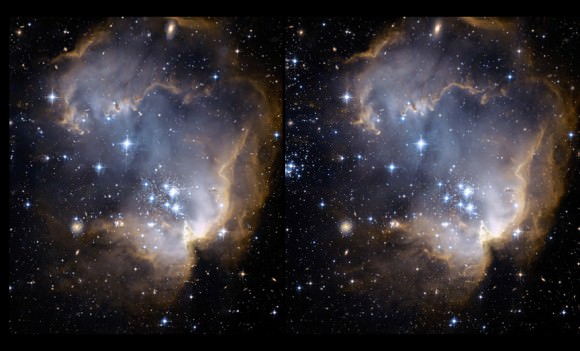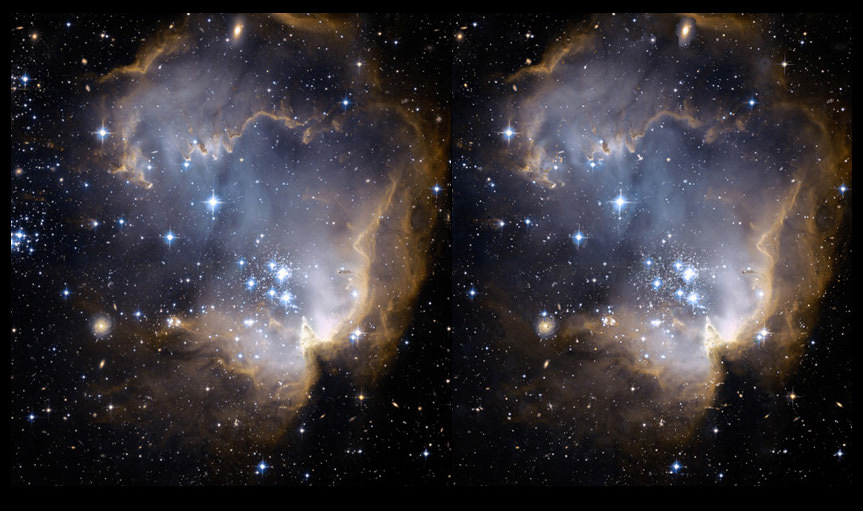[/caption]
It’s been awhile hasn’t it? Time may have passed, but absence makes the heart grow fonder. For those of you who have missed our very special dimensional looks into the Cosmos, then it’s high time we let our minds and eyes relax and we take a 200 thousand light-year distant journey towards the edge of the Small Magellanic Cloud for a look at a bright, young open cluster of stars known as NGC 602…
Whenever we present a dimensional visualization it is done in two fashions. The first is called “Parallel Vision” and it is much like a magic eye puzzle. When you open the full size image and your eyes are the correct distance from the screen, the images will seem to merge and create a 3D effect. However, for some folks, this doesn’t work well – so Jukka has also created the “Cross Version”, where you simply cross your eyes and the images will merge, creating a central image which appears 3D. Upon further study, we’ve also come to realize that there is a certain percentage of people who also are unable to make this happen as well. You aren’t weird – just a percentage. Here’s why…
Typical for hunting animals (as opposed to ‘prey’ animals), we have our eyes set in the front of our heads. Our eyes are typically about 2½ inches apart, and so they see slightly different versions of the scene in front of them, from which the visual part of our brain constructs an internal three-dimensional model. Thus a human being can directly estimate the distance of something without moving a muscle – an important evolutionary advantage for a hunter. The trick is to then ‘fool’ the brain into processing the photographic images as if they really were distant scenes, not just color photos a few inches away. First, you will need a piece of white card, about 12 inches long. You hold the card vertically between your eyes and the pictures, so that it touches the centerline of the stereo pairs. Next? A pair of cheap reading glasses. If you usually have to wear reading glasses then you’ll need a higher power. Try different pairs in the store until you find one that will allow you see sharply no further away than a little over 12 inches. That’s it! Then sit back, relax and prepare to be blown away…

Cruising along some 200 thousand light-years away from the Milky Way is the Small Magellanic Cloud – a satellite galaxy of ours. Sitting on its edge is cloud of gas and dust which comprise a nebula known as M90, and within it shines a sparkling cluster of new stars called NGC 602. But these new stars aren’t shy… They’re hot and massive. The radiation and shock waves which pour from them have pushed the nebula away, compressing it and triggering new star formation. While these pre-main sequence embryonic suns lay hidden to all but infrared wavelengths, the beauty of this area is the chemical properties it shares with our own galaxy.
According to the studies of L.R. Carlson (et al) NGC 602’s star formation at a low chemical abundance makes it a “good analog to the early universe in terms of examining the processes and patterns of star formation. This cluster in particular is ideally suited to this aim. Its location in the wing of the SMC means that, while its chemical properties should be similar to those of the rest of the galaxy, it is relatively isolated.” Isolated… But young, very young. Says Carlson, “This pre-Main Sequence population formed coevally with the central cluster about 5 million years ago. Spitzer Space Telescope (SST) images of the region in all four Infrared Array Camera (IRAC) bands reveal a second population of Young Stellar Objects (YSOs), which formed after the stars seen with HST/ACS imaging. Some of these very young objects are still embedded in nebular material. We infer that star formation started in this region less than five million years ago with the formation of the central cluster and gradually propagated towards the outskirts where we find evidence of on going star formation less than a million years old.”
Another interesting factor is NGC 602’s position in the wing of the Small Magellanic Cloud leading to the Magellanic Bridge – a stream of neutral hydrogen which connects the two Magellanic Clouds like a invisible cord. While it’s mostly comprised of low-metallicity gas there have been two early-type stars found inside it. The Magellanic Bridge is also a favored region for investigations of interstellar gas and star formation in very low metallicity region… Much like the home of our bright young cluster. Why is this so fascinating? Because studying star formation in regions like this gives astronomers a look at what may happen during galaxy formation – long before heavier elements are created from successive generations of stars undergoing nuclear fusion.
So, as you look deep into this bridge between the stars, gaze with wonder at the long “elephant trunks” of dust and turn your mind towards these beautiful, bright blue stars still forming from gravitationally collapsing gas clouds. It is a very unique event, occurring where it should not happen – but is. A true bridge between the stars…
And touchstone to the Cosmos.
Many thanks to Jukka Metsavainio for his magic with Hubble Space Telescope images and allowing us this incredible look inside another mystery of space.


Please provide more “Parallel Vision” images whenever possible. THIS one was GREAT! To Hell with those red/blue glasses.
this one turned out well –
There must be something wrong with my eyes. I can’t get any of these images to work. I can do magic eye books, but for some reason, I can’t do it.
Thank YOU, Yukka and Tammy, this is a new favourite. The distant galaxy in the lower left draws me magically towards it.
So, I’m a hunter animal? That’s an unusual thing to learn on an astronomy web site…
al? honest, there is nothing wrong with you. according to statistics, about 12% of americans and europeans don’t have stereo vision, and many of them don’t even realize it. it might be due to damage to one eye, or to a severe focus deficit, or simply to the fact that for some reason that person’s brain just didn’t make the right connections to see in stereo. it doesn’t make you weird, or mean there is something wrong with your eyes – it just means you can’t.
if you have time to play with the image, try separating the two of them slightly and using the divider trick. how i wish we could make it work for everyone!!
Actually, measuring these images, the stereo is so far out, a lot of individuals (me being one) either have to cross their eyes to make it happen, or somehow “over relax” them because the images are farther apart than my eyes are. I am willing to bet I am not the only one who falls into this. If you copy the image and decrease the size by about 10-15% in your favorite image editor, you can easily see it.
Stereo images cannot be further spaced out than your pupils or you have to be able to “over relax” your eyes (ie, reverse cross eyed).
I am in the camp with eye foreone. I have never been able to get the parallel to work, but the crossed works fine with me. Tammy, for the parallel how far away from the image works best?
ok, this is probably going to sound incredibly dumb – but it’s what works for me.
i wear very mild reading glasses when at the computer (diopter 1.25), so i open the full size parallel image and take them off. when i get away from the monitor – about a meter or maybe even a little more, i let my eyes relax like i was doing a magic eye puzzle or averted vision. it’s similar to crossing my eyes – but not as forced. my vision is sharp at that distance and all at once the pictures will just seem to merge and i focus my attention on the clearest of the images – that’s the one that seems dimensional. but what works for me might not work for someone else.
certain features really amaze me… two of the background galaxies really snap out and the lower area of the nebula below the cluster looks like you could virtually reach into it. i understand the mechanics behind how it works – yet it never ceases to fascinate me!
i really feel bad that there are some folks who can’t see this, because it really is mind-blowing. even if the cross-eyed version is a little more quick and strained, it still staggers my imagination!
an easier way for me: mirror the right image with a paint program; hold a small mirror vertically between the images -> approach the picture till your nose touches the edge of the mirror => with your left eye you look at the left picture, with your right eye you look at the right picture in the mirror
Hi Tammy,
You say “certain features really amaze me… two of the background galaxies really snap out” and Feenixx also says distant galaxies.
As I see the image, the two galaxies (the largest) seem to be in the forground at ~12:30 and ~7:30 and the one at ~7:30 has a smaller one right below it and another to its right both appearing to be in front of the SMC.
I would have really enjoyed reading about how the parallax was created for these images. I have a hard time believing that just the orbit of earth around could create that depth of field with an object that is so very distant. I mostly read the article to find out about that. Am I wrong?
Tammy & Jukka
Yet again, another outstanding contribution. Just when I think you’ve grabbed the brass ring, out comes another masterpiece!
When in the world are you going to publish a book of these wonders?
Yowzer…once again you have done it, an absolutly outstanding stereo photograph, super. As usual it took me three seconds to focus it in and get the 3-D image. It is just a matter of being the correct diatance from the moniter for the process to work. Reminded me of a dragon about to gobble a small group of stars. Super job. I second the motion that all of these be collected (after you have done about 50 of them) and published in a book and I want a signed first edition.
Vernon
The Stargeezer